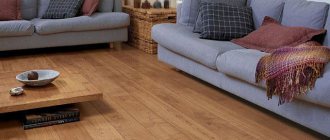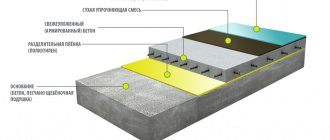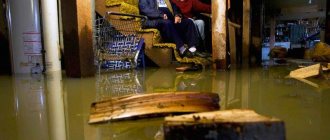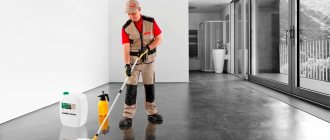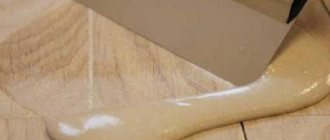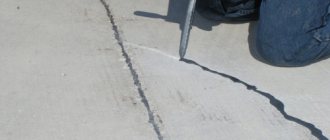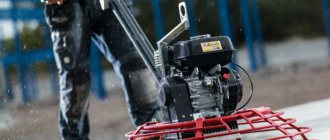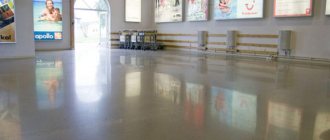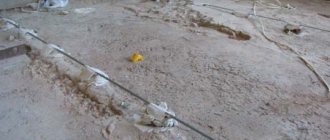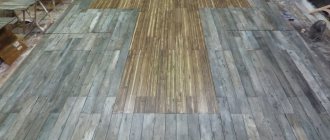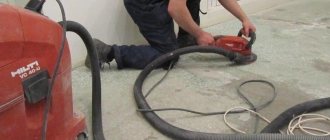Coverings for outdoor use
Coverings for outdoor sports fields, outdoor cafes, summer terraces and restaurants are in great demand today. However, very special requirements are imposed on the arrangement of such floors. This is due to the fact that outdoor coatings are constantly exposed to moisture, sun, winds, as well as groundwater and temperature changes. Therefore, the key requirement for outdoor flooring is resistance to all of the above mentioned influences.
Basic qualities of flooring for outdoor use
Today, traditional street coverings such as concrete screed are gradually being abandoned. Concrete quickly deteriorates under the influence of precipitation and sun, and frosts are completely destructive for concrete. Concrete paths can be used to create garden paths, however, to prevent premature destruction of concrete, it is necessary to strengthen it using topping or special impregnation.
Polymer impregnation for concrete, unfortunately, is not able to completely replace a good polymer self-leveling coating, but it helps to extend the service life of concrete.
Today, concrete screed is gradually being replaced by self-leveling floors, installed both indoors and outdoors. Such coatings are ideal for outdoor use, since they are practically not subject to destruction due to exposure to precipitation and temperature changes.
Self-leveling coatings installed outdoors are also resistant to vibration, abrasive influences and constant mechanical loads. This makes them the optimal choice for arranging outdoor sports grounds, outdoor cafes with high traffic, etc.
Any flooring installed outdoors must be waterproof, otherwise it will very quickly become saturated with groundwater and precipitation. Even if the site is equipped with a canopy, some amount of moisture will still fall on it, so this factor should be taken into account when choosing a floor covering.
In addition, among the main requirements for outdoor floor coverings is a pleasant appearance. Also, the coating should not be slippery, even if it gets wet. Otherwise, it may result in injury.
Finally, outdoor flooring is subject to more intense wear and tear, so repairs should be simple and quick. Polymer seamless floors also meet this requirement.
Floor coverings for outdoor sports grounds
As a covering for an outdoor sports ground, it is necessary to choose the material that will allow you to obtain a completely smooth, durable and environmentally friendly coating. Flooring technology also plays a significant role.
Thus, the coating on an outdoor sports ground can be laid on top of a sand and gravel substrate - this will prevent the destruction of the coating due to erosion of the soil or its subsidence. The base can also be asphalt or concrete. In this case, the top layer of the base substrate must be properly prepared, first cleaned and treated with a primer. This will ensure complete adhesion to the finish coat. After which a polymer coating is applied. The thickness of the base must be at least 1 cm.
In addition to polymers, PVC, artificial turf, etc. can serve as a covering for an outdoor sports field. The choice of coverage is determined by the purpose of the site. However, only polymer coating remains universal.
Flooring for outdoor terraces and cafes
For owners of street cafes and terraces, the external attractiveness of the establishment is important. The flooring also plays a significant role here - it should not only be convenient and comfortable for visitors, but also have a pleasant appearance.
A good option for a street cafe would be a floor made of natural wood. However, even with special impregnation for wood, such a coating is very vulnerable to precipitation and temperature changes. The wood darkens, cracks, and the varnish on it quickly wears off, especially if the cafe has good traffic.
For outdoor cafes, polymer flooring may be the best choice. In addition to being invulnerable to the vagaries of the weather and resistant to mechanical stress, polymer floors provide the cafe owner with much more opportunities to create an individual design: you can make a transparent floor, insert drawings or even small decorations into it, apply the cafe’s logo, and so on. This solution will help increase the influx of customers.
Types and creation process
Polyurethane or epoxy polymers can be used to construct self-leveling surfaces. Quartz sand is used as a filler for such coatings, which helps to give the surface greater strength.
As for classification, such coatings are divided into three types depending on the thickness of the coating and its composition.
Thus, a small amount of quartz sand is contained in thin-layer self-leveling floors, the thickness of which does not exceed one millimeter. Up to fifty percent of sand can be contained in self-leveling self-leveling floors, the thickness of which can reach five millimeters. About eighty-five percent quartz filler can be found in high-fill floors, which range in thickness from 5 to 8 mm.
Thin-layer polymer coatings are also called paint coatings. They are advisable to use in cases where it is important to prepare industrial coatings quickly and affordably from a financial point of view. However, under significant mechanical loads, such surfaces wear out very quickly.
However, this method is used to protect the concrete base. Moreover, in this way you can significantly improve the surface, making it decorative. In the process of creating thin-layer coatings, careful preparation of the base is required. This is what guarantees the long service life of such surfaces.
Self-leveling self-leveling floors are considered the most universal - they are distinguished by their high aesthetics and smooth surface.
They can be used in any room, regardless of the level of mechanical loads on the floor. The advantages of such coatings include not only durability, but also resistance to chemicals, abrasion, elasticity, hygiene, ease of installation and maintenance.
Concrete polymer floors have the greatest resistance to wear. In addition, they are highly resistant to impacts and abrasions. These types of coatings are the so-called polymer concretes - they contain not only a significant amount of quartz sand, but also many additional fillers that make it possible to create antistatic and other surfaces with special properties.
Durakon PL
350 microns Colorless paint coating 360 RUR/sq.m. Duracon BC 4 mm Highly filled, moderately rough RUB 1,840 per sq.m. Duracon TR 6 mm Highly filled thick-layer coating RUR 2,730 per sq.m.Manufacturers
Epoxy and polyurethane coatings with quartz sand as a filler (including colored ones) are presented by the companies Remmers, Sika and Caparol. Mixtures used in dry form to strengthen concrete floor surfaces are produced by Multitop, Armorit, Panbex and Bausil.
When choosing a specific manufacturer, you should take into account not only the price range of the solutions they offer, but also the company’s reputation in the world market. Moreover, well-established companies have a high level of service and offer a longer warranty period for their products.
EPOXY FLOORS
Monepox 110 BC 500 microns Paint reinforced coating 480 RUR/sq.m. Monepox Coracoat SL 2 mm Self-leveling glossy coating 1320 RUR/sq.m. Monepox Compact 4 mm Highly filled leveling coating RUR 1,790 per sq.m.Advantages of coverage
A high-tech polymer floor can last at an industrial facility for ten years or more. It is advisable to use this type of coating in those facilities where hygiene requirements are high, since due to their seamlessness and monolithic nature, cleaning them is not difficult.
Most often, bulk polymer mixtures are used as repair mixtures for concrete foundations.
Among the advantages of polymer materials are durability, wear resistance, and resistance to all external influences, including temperature, abrasive and chemical. During operation, a polymer floor does not require preventive procedures, and repair work can be performed locally.
POLYURETHANE FLOORS
Hardtop 250 microns Paintable matte protective coating 180 rubles per sq.m. Monopur SL 3 mm Self-leveling chemical-resistant coating RUB 1,480 per sq.m. Monopur Industry 6 mm High-strength universal coating RUR 2,800 per sq.m.How to choose the right polymer floors for concrete
The main polymer materials for self-leveling coatings are polyurethane and epoxy components. Previously, polyurethane-based floors were considered something scarce, since imported components were used in the process of their creation.
Today, the difference in price is not so obvious, and the production of all components is established in our country. That is why the main criterion for selection is the technical characteristics of the material. Thus, surfaces based on polyurethane components have high elasticity, better abrasion resistance and impact strength.
Due to this, the area of use of such materials is surfaces subject to significant abrasive and impact loads. As for epoxy coatings, they are more resistant to ultraviolet radiation and chemical attack. They are also distinguished by high hardness. In addition, such coatings can be installed at a certain moisture content of the concrete coating - from four to six percent.
Features of self-leveling floors for finishing
Self-leveling finishing mixtures: characteristics and types
Polyurethane self-leveling floor for outdoor use.
This category includes thin-layer, highly mobile polymer-based compounds. After curing, a seamless coating with increased strength properties is formed. They are used at the final stage to protect the surface from abrasive loads, strengthen and remove dust from concrete. They are often used to create an anti-slip floor with a beautiful decorative effect. In demand in garages, parking lots, terraces, home areas, etc.
Self-leveling finishing floors are one- or two-component compounds. In the first case, polymerization occurs as a result of the elastomer binding moisture from the air. In the second, the process begins by mixing the hardener (activator) with the base. There are mixtures:
- Polyurethane (Remmers PUR Aqua, Huntsman Poliplan);
- Epoxy (SdelaiPOL Etalon, Enekon Eneklad CFS);
- Polymer cement liquid (Remmers Crete, CMT PurCem);
- And etc.
The first two types are most widespread, since the rest are used mainly at large industrial facilities.
Epoxy self-leveling floor for outdoor use.
According to experts, polyurethane-based compounds are more elastic and cover small cracks and minor defects in the base well. Recommended for areas completely or partially protected from direct sunlight, as the coating turns yellow over time under their influence. Used for covered verandas, balconies, street cafes, exhibition facilities, etc.
Epoxy compounds create a very abrasion-resistant film, so they are well suited for parking lots, home areas with a high level of foot traffic, roadways, entertainment complexes, etc. The surface is partially repairable.
A coating based on epoxy resins can be used without a protective canopy, since neither heat nor rain and snow are harmful to such a floor. Many formulations contain UV protective additives, so they “hold” the color for a long time.
The difference between mixtures for interior and exterior use is frost resistance. To prevent the finished coating from cracking due to temperature changes, modifying additives are added to the compounds to provide the necessary elasticity to the coatings.
Polymer compositions are convenient because they can be applied to almost any material of mineral, cement or organic type: concrete, brick, stone, asphalt, slate, metal, wood and others. Some compounds work even on such capricious surfaces as marble and polished ceramic tiles. After application, the compound seals and strengthens the base and removes dust. Monolithic coating is very easy to keep clean, but difficult to damage. Minimum service life is 10 years or more.
Installation of thin-layer finishing self-leveling floors
The basic requirements for the base are identical for all manufacturers: an absolutely flat, durable (from 200 kgf/cm2), dry (up to 4% CM) surface. Must not be:
- Places with standing water, dew drops;
- Slope more than 3%;
- Cement laitance, traces of dirt, oil, dust;
- Weak or peeling areas.
All defects are eliminated by grinding, milling or sandblasting. Holes and potholes are filled with quick-drying repair compounds. The permissible base temperature for work is from +10 to +25 ° C, relative air humidity is no more than 80%.
Mixing the Base and Activator of the self-leveling coating
Before pouring, the surface can be primed 1-2 times. It is advisable to use materials from the same series. After drying, mix the components, pour over the surface, spread evenly with a spatula and roll with a needle roller to remove air bubbles.
Epoxy compounds are generally thicker than polyurethane compounds. Similar to mastic or floor enamel, only the layer is thicker - up to 3 mm. Therefore, it is applied with a paint roller. To create an anti-slip surface, after painting, chips or other decorative fine-grained fillers are scattered over it. After 3-7 days the floor is ready for use.
Advice! If you need repairmen, there is a very convenient service for selecting them. Just send in the form below a detailed description of the work that needs to be performed and you will receive proposals with prices from construction teams and companies by email. You can see reviews about each of them and photographs with examples of work. It's FREE and there's no obligation.
How thin-layer coatings are applied
The method is practically no different from the simple technology of painting concrete. The floor is “ennobled” with a layer of polymer.
The following sequence of actions is performed:
- In a clean container, mix the polymer coating composition for two to three minutes. For these purposes, PolaRemont.ru recommends using a drill with a special attachment. Pay special attention to the bottom layer. It is necessary to ensure uniform distribution of the pigment sediment;
- Polymer paint is applied to the base with a roller. Half a kilogram is consumed per square meter. The amount of material required may increase if the polymer is applied to a highly porous, unprimed substrate.
- To make the coating dry faster, the room must be ventilated. The main thing is to keep out sunlight and dust.
Self-leveling floor for the street: properties, purpose, installation
Self-leveling flooring is a high-quality seamless cement-polymer floor covering that is used to perfectly level the floor surface. Self-leveling outdoor flooring is used in the construction of parking lots, industrial warehouses and retail spaces.
- sealed;
- thin;
- frost-resistant;
- does not crack;
- fireproof;
- does not emit harmful substances;
- resistant to bacteriological attack and decay;
- has good adhesion to concrete surfaces.
Before installing the self-leveling floor, it is necessary to prepare the base - level, polish, clean from dirt and dust. Prime the seams and apply sealant using a roller, spatula or paint brush. Next, prepare the solution according to the instructions on the package and apply evenly.
The construction hypermarket "Master Tibot" sells a wide range of self-leveling floors at affordable prices from leading manufacturers of dry construction mixtures. We deliver goods throughout Moscow and the Moscow region. The current cost of poured flooring is indicated in our online store.

